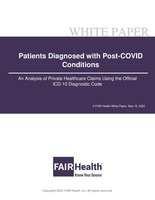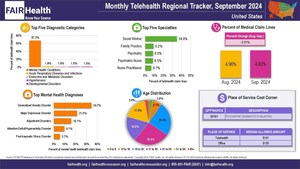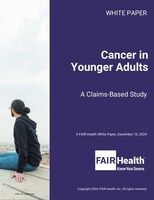New FAIR Health Study Reports 76 Percent of Patients Diagnosed with Post-COVID Conditions Had Never Been Hospitalized for COVID-19
Age Group 36 to 50 Most Likely to Be Diagnosed with Post-COVID Conditions; Females More Likely Than Males to Receive Such Diagnoses
Thirty-One Percent Had No Identified Preexisting Chronic Comorbidities
NEW YORK, May 18, 2022 /PRNewswire/ -- The majority (75.8 percent) of patients diagnosed with a post-COVID condition had never been hospitalized for COVID-19, according to a new study from FAIR Health. Among patients who presented with a post-COVID diagnosis, 81.6 percent of females had not had a COVID-19 hospitalization compared to 67.5 percent of males.
The study was among the first to use the official ICD-10 diagnostic code (U09.9) for post-COVID conditions that became effective October 1, 2021. Analyzing private claims data from 78,252 patients diagnosed with the U09.9 code from October 1, 2021, to January 31, 2022, the study was released today as a white paper entitled Patients Diagnosed with Post-COVID Conditions: An Analysis of Private Healthcare Claims Using the Official ICD-10 Diagnostic Code.
Also known by such terms as long COVID and post-acute sequelae of COVID-19, post-COVID conditions comprise a wide range of health problems that may occur four weeks or more after infection with the virus that causes COVID-19. In the new FAIR Health study, the population of patients diagnosed with post-COVID conditions is analyzed by COVID-19 hospitalizations, age, gender, number of days from initial COVID-19 diagnosis to last post-COVID diagnosis during the study period, preexisting chronic comorbidities, co-occurring diagnoses and risk scores. Among the key findings:
- The age group 36 to 50 was the most likely to be diagnosed with U09.9 post-COVID conditions; 34.6 percent of patients with that diagnosis were in that age group.
- Females were more likely than males to be diagnosed with U09.9 post-COVID conditions. Females made up 59.8 percent of the population of patients with that diagnosis, while males made up 40.2 percent. By comparison, within the cohort of people diagnosed with COVID-19 in the FAIR Health repository, 53.8 percent of patients were female and 46.2 percent were male.
- Of patients who presented with a U09.9 post-COVID condition, 30.7 percent had no identified preexisting chronic comorbidities.
- The three diagnoses most commonly co-occurring on the same claim line with the U09.9 post-COVID diagnosis in patients across all ages and genders were abnormalities of breathing (23.2 percent of patients with post-COVID conditions), cough (18.9 percent) and malaise and fatigue (16.7 percent).
- In patients with a U09.9 post-COVID diagnosis, certain co-occurring diagnoses were more common in some age groups than across all age groups: for example, multisystem inflammatory syndrome in patients aged 0 to 12; abnormalities of heartbeat in the age group 13 to 22; generalized anxiety disorder in patients aged 23 to 35; and hypertensive diseases in the age group 65 and older.
- "Other and unspecified myopathies" (diseases that affect the muscles that control voluntary movement) occurred in patients in the post-COVID population 11.1 times more often than in the same population prior to COVID-19. Pulmonary embolism occurred 2.6 times more often. "Other disorders of brain," including post-viral fatigue syndrome and certain forms of encephalopathy, occurred two times more often.
- On average, in all age groups, patients with a U09.9 post-COVID condition had higher Department of Health & Human Services-Hierarchical Condition Category (HHS-HCC) risk scores after their diagnosis of COVID-19 than before. HHS-HCC risk scores identify which patients are likely to consume more healthcare resources and potentially incur more healthcare-related costs in the long run.
FAIR Health President Robin Gelburd stated: "Post-COVID conditions have become an issue of growing national concern. FAIR Health is pleased to shed light on this issue using the official ICD-10 diagnostic code for such conditions that became effective last fall. We hope these findings prove helpful for all individuals diagnosed with post-COVID conditions, as well as for providers, payors, policy makers and researchers."
This is the second FAIR Health study on post-COVID conditions; the first was released in June 2021, before the ICD-10 code for such conditions became effective. Other FAIR Health studies on the COVID-19 pandemic have examined projected US costs for COVID-19 patients requiring inpatient stays, the impact of the pandemic on hospitals and health systems, the impact on healthcare professionals, key characteristics of COVID-19 patients, the impact on the dental industry, risk factors for COVID-19 mortality, the impact on pediatric mental health and treatment and hospitalization costs.
For the new white paper, click here.
Follow us on Twitter @FAIRHealth
About FAIR Health
FAIR Health is a national, independent nonprofit organization that qualifies as a public charity under section 501(c)(3) of the federal tax code. It is dedicated to bringing transparency to healthcare costs and health insurance information through data products, consumer resources and health systems research support. FAIR Health possesses the nation's largest collection of private healthcare claims data, which includes over 36 billion claim records and is growing at a rate of over 2 billion claim records a year. FAIR Health licenses its privately billed data and data products—including benchmark modules, data visualizations, custom analytics and market indices—to commercial insurers and self-insurers, employers, providers, hospitals and healthcare systems, government agencies, researchers and others. Certified by the Centers for Medicare & Medicaid Services (CMS) as a national Qualified Entity, FAIR Health also receives data representing the experience of all individuals enrolled in traditional Medicare Parts A, B and D; FAIR Health includes among the private claims data in its database, data on Medicare Advantage enrollees. FAIR Health can produce insightful analytic reports and data products based on combined Medicare and commercial claims data for government, providers, payors and other authorized users. FAIR Health's systems for processing and storing protected health information have earned HITRUST CSF certification and achieved AICPA SOC 2 compliance by meeting the rigorous data security requirements of these standards. As a testament to the reliability and objectivity of FAIR Health data, the data have been incorporated in statutes and regulations around the country and designated as the official, neutral data source for a variety of state health programs, including workers' compensation and personal injury protection (PIP) programs. FAIR Health data serve as an official reference point in support of certain state balance billing laws that protect consumers against bills for surprise out-of-network and emergency services. FAIR Health also uses its database to power a free consumer website available in English and Spanish, which enables consumers to estimate and plan for their healthcare expenditures and offers a rich educational platform on health insurance. An English/Spanish mobile app offers the same educational platform in a concise format and links to the cost estimation tools. The website has been honored by the White House Summit on Smart Disclosure, the Agency for Healthcare Research and Quality (AHRQ), URAC, the eHealthcare Leadership Awards, appPicker, Employee Benefit News and Kiplinger's Personal Finance. FAIR Health also is named a top resource for patients in Dr. Marty Makary's book The Price We Pay: What Broke American Health Care—and How to Fix It and Dr. Elisabeth Rosenthal's book An American Sickness: How Healthcare Became Big Business and How You Can Take It Back. For more information on FAIR Health, visit fairhealth.org.
Contact:
Rachel Kent
Senior Director of Marketing
FAIR Health
646-396-0795
[email protected]
SOURCE FAIR Health

WANT YOUR COMPANY'S NEWS FEATURED ON PRNEWSWIRE.COM?
Newsrooms &
Influencers
Digital Media
Outlets
Journalists
Opted In







Share this article